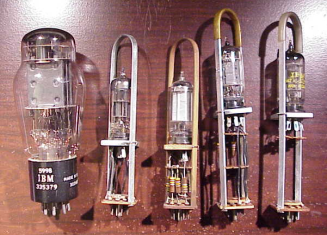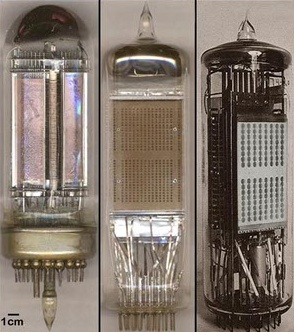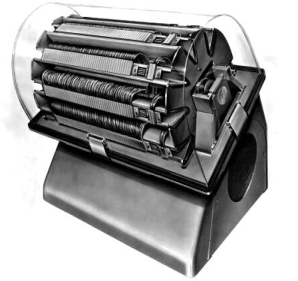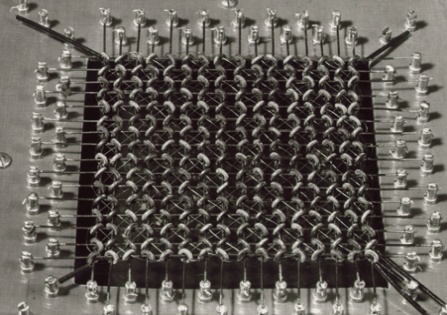Evolution of RAM
A Brief History of the Evolution of RAM Computer Memory
Let's focus on the major types of computer memory in history.
Vacuum Tubes - A vacuum tube or thermionic valve could be used to create an electrical signal by controlling electrons movements in a vacuum of space. The Geissler Tube was developed by Heinrich Geissler in 1857. The Crookes Tube was developed by William Crookes. Many scientist in the 19th century experimented with vacuum tubes, Eugen Goldstein, Nikola Tesla and Thomas Edison. In the 1940's research was conducted on cathode ray tubes as data storage. In 1946 Sir Fredrick Williams and Tom Kilburn co invent the Williams Tube , a type of cathode ray tube. In 1948 Kilburn designed the Manchester Baby- the first computer to use a stored program. Vacuum tubes were connected to relay lines made up of mercury and nickel wire (precursor to core memory). In 1946 the Eniac computer was built. " The ENIAC contained 17,468 vacuum tubes , along with 70,000 resistors, 10,000 capacitors, 1,500 relays, 6,000 manual switches and 5 million soldered joints. It covered 1800 square feet (167 square meters) of floor space, weighed 30 tons, and consumed 160 kilowatts of electrical power." (Inventors.about.com, 2010)
Photo Left: Early Vacuum Tube. Photo Right Vacuum Tube 1950-1960's.
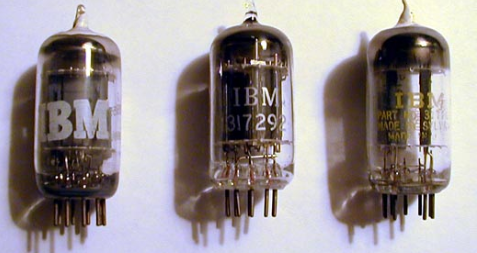 |
Drum Memory - Invented in 1932 by Gustav Tauschek, used throughout the 1950's and 1960's, drum memory used a metal cylinder coated with ferro-magnetic material. The drums have read and write heads along the axis. Media such as paper tape or punch cards were used to feed instructions onto the drum. This was an early form of (read only memory). The heads were fixed so seek time is determined by rotational speed. The electronic drum memory - 1942, was a magnetic storage device which was eventually replaced by core memory.
Photo Left Early Drum Memory 1932 Photo Right: IBM 650 Drum memory 1950.
Magnetic Drum memory video: http://www.youtube.com/watch?v=eIpoA7Ir9p8
Core Memory - Uses magnetic ferrite rings which have wires threaded thru them. Information can be stored by the polarity of the magnetic field they contain. "Sending current through the wires causes the core to hold a charge to represent zero or one." (White, 2008). The first magnetic core patent was issued to Fredrick Viehe in 1947. Core memory was further developed by Ann Wang. Kenneth Olsen also developed magnetic core memory in 1947. Most notably he improved upon (Jay Forrester -1949 core memory) original system. Olsen co founded Digital Equipment Corporation. Forrester invented random- access, coincident-current magnetic storage.
Photo center: Core Memory 1951, Jay Forrester files patent for Core Memory.
Transistor/ Semiconductors - "A transistor is essentially a vacuum tube built not to human size but on a microscopic scale. Because it's small, a transistor requires less power to generate the flow of electrons. Because it uses less power, a transistor generates less heat, making computers more dependable." (White, 2008) "Transistors are not used simply to record and manipulate numbers. The bits can just as easily stand for true (1) or not true (0), which allows computers to deal with Boolean logic." (White, 2008) Transistors can be combined into logic gates which then handle Boolean logic. A transistors smaller size and less heat buildup, is the crucial event in history that changed computing. This text from About.com by Mary Bellis, details the evolution of the transistor, " The transistor is an influential invention that changed the course of history for computers. The first generation of computers used vacuum tubes; the second generation of computers used transistors; the third generation used integrated circuits; and the fourth generation of computers used the microprocessor".( Bellis, 2010).
Photo left: The first Transistor Photo Right: Jack Kilby Integrated Circuit 1958
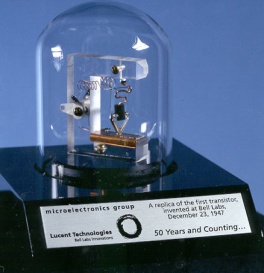 |
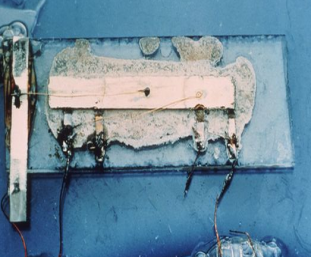 |
|---|
Do you see the evolution link?
Punch Cards/Gears levers/Vacuum Tubes - Please see this detailed chart. A History of Information Technology and Systems.
Drum Memory/Magnetic Tape
Core Memory
Transistorized Memory
RAM
